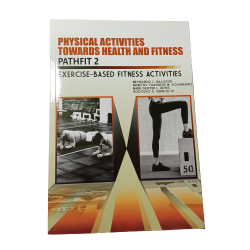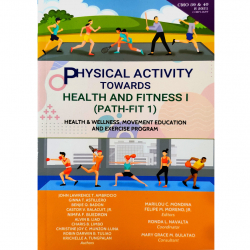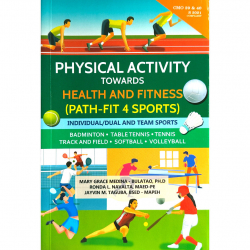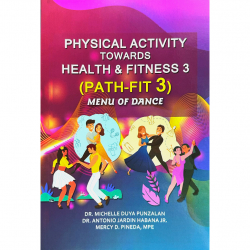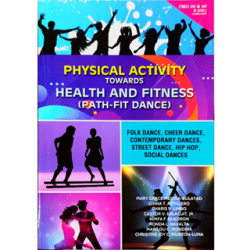Physical activity towards health & fitness 1 (PATH-FIT 1) health & wellness, movement education and exercise program
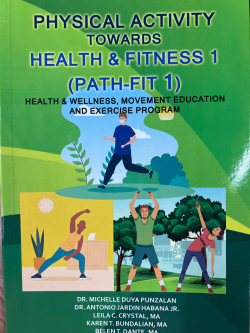
Buy online ($)
Type
Book
Authors
ISBN 13
9789719655565
Category
Filipiniana-Circ.
[ Browse Items ]
Publication Year
2023
Publisher
Mindshapers, Philippines
Pages
vi, 136 p.: ill.
Subject
1. Physical education--Textbooks. 2. Physical--Fitness.
Abstract
Movement is one of the significant features of all living beings.
It is a fundamental aspect of human life. It affects everything from
circulation to digestion to metabolism to immunity. The body
contributes far more to our life than just physical attributes such as
strength and endurance. It plays an indispensable role in emotions,
learning and relationships.
In Physical education we learn to move and we move to learn.
Move to learn is the context of physical activity as the means for
learning, while learn to move embodies the learning of skills,
and techniques and the acquisition of understanding that are
requisites to participation in a variety of physical activities that
include exercise, games, sports, dance and recreation. The best way
therefore to improve movement is to move.
Movement competencies are essential to participate in physical
activity. If movements are not developed or nurtured from young
age, this can lead to inactivity and the health and social problems
linked to it.
Movement competence is the development of sufficient skill
to assure successful performance of different physical activities.
Movement competency on the other hand is the ability to move
free from dysfunction or pain.
Movement competency training starting from locomotor to
non-locomotor to mobility training are vital for the development of
one's strength, endurance, flexibility, power and balance. Mobility
training combines mobility exercise that increase the range of
movements and motions your body can perform.
Mobility is one attribute of fitness. Fitness can be achieved
through mobility training which increases the motion with joints
and surrounding muscles, recover faster and perform better.
It is in this light that this book is written. This book is also
aligned with CHED Memo in offering PATHFIT (Physical Activities
Towards Health and Fitness) 1, 2, 3 and 4 in the Tertiary Physical
Education Program.
It includes chapters that highlight activities like locomotor
movements, non- locomotor movements and mobility training for
students' movement competence. It also values the importance of
healthy habits which will make the individual free from sickness
and infirmity.
This book also discusses fad diets and food labeling explained
in simple manner so as it will be easier to be understood by the
students. This book is also a product of the authors' journey as
Physical Education teachers in their respective institutions.inos
Overall, this book will help students to achieve holistic
development thus, be productive members of the society where they live.
THE AUTHORS
It is a fundamental aspect of human life. It affects everything from
circulation to digestion to metabolism to immunity. The body
contributes far more to our life than just physical attributes such as
strength and endurance. It plays an indispensable role in emotions,
learning and relationships.
In Physical education we learn to move and we move to learn.
Move to learn is the context of physical activity as the means for
learning, while learn to move embodies the learning of skills,
and techniques and the acquisition of understanding that are
requisites to participation in a variety of physical activities that
include exercise, games, sports, dance and recreation. The best way
therefore to improve movement is to move.
Movement competencies are essential to participate in physical
activity. If movements are not developed or nurtured from young
age, this can lead to inactivity and the health and social problems
linked to it.
Movement competence is the development of sufficient skill
to assure successful performance of different physical activities.
Movement competency on the other hand is the ability to move
free from dysfunction or pain.
Movement competency training starting from locomotor to
non-locomotor to mobility training are vital for the development of
one's strength, endurance, flexibility, power and balance. Mobility
training combines mobility exercise that increase the range of
movements and motions your body can perform.
Mobility is one attribute of fitness. Fitness can be achieved
through mobility training which increases the motion with joints
and surrounding muscles, recover faster and perform better.
It is in this light that this book is written. This book is also
aligned with CHED Memo in offering PATHFIT (Physical Activities
Towards Health and Fitness) 1, 2, 3 and 4 in the Tertiary Physical
Education Program.
It includes chapters that highlight activities like locomotor
movements, non- locomotor movements and mobility training for
students' movement competence. It also values the importance of
healthy habits which will make the individual free from sickness
and infirmity.
This book also discusses fad diets and food labeling explained
in simple manner so as it will be easier to be understood by the
students. This book is also a product of the authors' journey as
Physical Education teachers in their respective institutions.inos
Overall, this book will help students to achieve holistic
development thus, be productive members of the society where they live.
THE AUTHORS
Description
Contents:
Chapter 1: Anatomical positions
Chapter 2: Physical fitness
Chapter 3: Physical activity
Chapter 4: Exercise variables and principles, fitt principle and phases of exercise
Chapter 5: Non-locomotor movements
Chapter 6: Locomotor movements
Chapter 7: Mobility training
Chapter 8: Healthy eating habits
Chapter 1: Anatomical positions
Chapter 2: Physical fitness
Chapter 3: Physical activity
Chapter 4: Exercise variables and principles, fitt principle and phases of exercise
Chapter 5: Non-locomotor movements
Chapter 6: Locomotor movements
Chapter 7: Mobility training
Chapter 8: Healthy eating habits
Biblio Notes
Notes:
Includes bibliographical references.
Includes bibliographical references.
Number of Copies
4
| Library | Accession No | Call No | Copy No | Edition | Location | Availability |
|---|---|---|---|---|---|---|
| Main | 926 | Fil-C. GV481.4 P86 2023 | 1 | Filipiniana Section | Yes | |
| Main | 927 | Fil-C. GV481.4 P86 2023 | 2 | Filipiniana Section | Yes | |
| Main | 928 | Fil-C. GV481.4 P86 2023 | 3 | Filipiniana Section | Yes | |
| Main | 929 | Fil-C. GV481.4 P86 2023 | 4 | Filipiniana Section | No |
